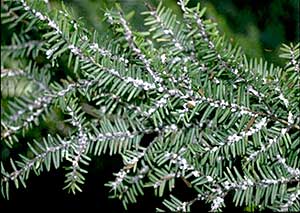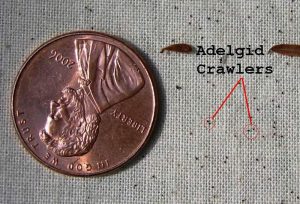By Jordan Haber
What’s the Buzz?
20 March 2020
Since the Hemlock Wooly Adelgid or HWA (Adelges tsugae) first arrived from Japan in the 1950s the invasive insect has decimated Eastern Hemlock (Tsuga canadensis) populations across Appalachia. Treating Adelgid infestations is both time consuming and costly, and even untreatable in cases of severe infestation. The best chances of treating hemlocks for Adelgids is to catch the insects before an outbreak occurs. According to recent findings by entomologist published in the Journal of Economic Entomology, sticky trap mechanisms are a cheap and easy way to determine areas most at risk of an outbreak.
The entomologists concluded that by placing sticky traps below the crown or canopy of Hemlock trees, scientists can monitor low density Adelgid populations and thus identify areas most at risk of an outbreak. The researchers concluded forest services can save both time and money by focusing on specific areas most at risk of an outbreak rather than targeting larger regions which may or may not be at risk.
The Adelgids are immobile for most of their life, but for a brief period of time before adulthood, the adelgids go through a mobile phase. During this phase, the Adelgids are nicknamed ‘crawler’s’. It’s during the ‘crawler’ phase that the adelgids will scale a hemlock to reach the crown or canopy where they lay eggs.
Eastern Hemlocks can grow too over 150ft tall and can live for more them 500 years which is why some refer to them as the ‘redwoods of the east’, regardless the adelgids are capable of scaling such heights. Although growing only slightly bigger than a pin head, in large numbers the adelgids can bring down even the biggest of hemlocks. According to Carol Loeffler, a professor of Biology at Dickinson College, “the adelgids feed on the Hemlocks sap causing needle drop-offs, limb die back, and in many cases tree mortality”.

The small cotton balls above are actually HWA egg sacs. Hatching generally occurs twice a year in Spring and Winter.
As Hemlock numbers continue to decline, ecologists worry that one of the most common tree species on the east coast will be gone by the end of the century.
“This has huge implications for wildlife” says Loeffler.
The Hemlock is a major source of food and shelter for small mammals and birds. If the Hemlock were to disappear from the forest, a lot more species than just the Hemlock could vanish.
By placing sticky traps beneath the canopy, the researchers were able to trap adelgids during the ‘crawler’ phase, and get an idea of which trees were most at risk of an outbreak. Of the 180 traps used, ‘crawlers’ were found in 115 of them. In Hemlocks where HWAs were caught in the sticky traps, adelgid egg cases were also found in the canopy. These findings suggest that sticky traps positive for ‘crawlers’ correlate to the presence of adelgid egg cases in the hemlock canopy. Thus, the more ‘crawlers’ observed in the traps, the more adelgid egg cases are likely to be found within a Hemlock’s canopy and the greater the risk of an outbreak.

Adelgid ‘crawlers’ are small, but what they lack in size they make up for in numbers. In North America all HWAs are female and they reproduce asexually. A single egg sac can contain hundreds of Adelgid nymphs.
To determine the impact of the sticky traps on low density adelgid populations, a comparison of canopy residing egg cases and trapped ‘crawlers’ was conducted. The results suggest that in adelgid infected sites where an array of three traps were used, around 85% of adelgids were removed.
These results suggest that sticky trap mechanisms may be an effective tool in controlling HWA outbreaks, especially if used as a preventative measure.
Going forward more research will have to be conducted regarding trap placements, as colonizing adelgid populations may be transported from the canopy of neighboring vegetation. It’s also important to keep in mind that these traps only prove effective in cases of low adelgid densities, and higher adelgid populations may call for more costly control measures such as insecticides use or controlled burnings. If the Eastern Hemlock is to have a fighting chance to continue to thrive in Appalachia’s forests it will be important for future research to focus on controlling high density HWA populations.
References:
Fidgen, G. J., Whitmore, C. M., Studens, D. K., MacQuarrie, J.K.C., and Turgeon, J. J. 2020. Sticky traps as an early detection tool for crawlers of Adelges tsugae (Hemiptera: Adelgidae). Journal of Economic Entomology 1-8.

Alex
"This title was very eye catching! That is so interesting that such a ..."
Alex
"This is really interesting! The fact that crops and plants are damaged is ..."
Alex
"Well done, this article is great and the information is very captivating! Ethics ..."
Alex
"I was intrigued throughout the whole article! This is such an interesting topic, ..."
Alex
"This is such an interesting article, and very relevant!! Great job at explaining ..."
Grandpa
"Honey You Did a good job I will forward to my eye doctor "
murphymv
"This article is fascinating because it delves into the details of the research ..."
murphymv
"I agree, adding the photo helped solidify the main finding. "
murphymv
"This is a fascinating finding. I hope this innovative approach to improving transplants ..."
Sherzilla
"This is a great article! I would really love to hear how exactly ..."
Sherzilla
"It's disappointment that these treatments were not very effective but hopefully other researchers ..."
Sherzilla
"I agree with your idea that we need to shift our focus to ..."
Sherzilla
"It's amazing to see how such an everyday household product such as ..."
Lauren Kageler
"I will be interested to see what the data looks like from the ..."
Lauren Kageler
"A very interesting article that emphasizes one of the many benefits that the ..."
maricha
"Great post! I had known about the plight of Little Browns, but I ..."
Sherzilla
"I assumed cancer patients were more at risk to the virus but I ..."
Sherzilla
"Great article! It sheds light on a topic that everyone is curious about. ..."
maricha
"This article is full of really important and relevant information! I really liked ..."
maricha
"Definitely a very newsworthy article! Nice job explaining the structure of the virus ..."
maricha
"It's interesting to think that humans aren't only species dealing with the global ..."
murphymv
"This is very interesting and well explained. I am not too familiar with ..."
Lauren Kageler
"Great article! This post is sure to be a useful resource for any ..."
Lauren Kageler
"Definitely seems like an odd pairing at first, but any step forward in ..."
murphymv
"What an interesting article! As you say, height and dementia seem unrelated at ..."
murphymv
"Great article! I learned several new methods of wildlife tracking. This seems like ..."
murphymv
"Very interesting topic! You explained cascade testing and its importance very well. I ..."
Alex
"This article is really interesting! What got me hooked right away was the ..."
Sabrina
"I found this article super interesting! It’s crazy how everyday products can cause ..."
Erin Heeschen
"I love the layout of this article; it's very eyecatching! The advancements of prosthetics ..."
murphymv
"Awesome article! I like the personality in the writing. Flash Graphene not only ..."
murphymv
"Very interesting work! I don't know a whole lot about genetics, but this ..."
Cami Meckley
"I think the idea of using virtual reality technology to better help prepare ..."
Erin Heeschen
"I wonder if there's a connection between tourist season and wildfires in the ..."
Ralph berezan
"Not bad Good work "
Michelle
"This sounds like it would be a great tool for medical students! ..."